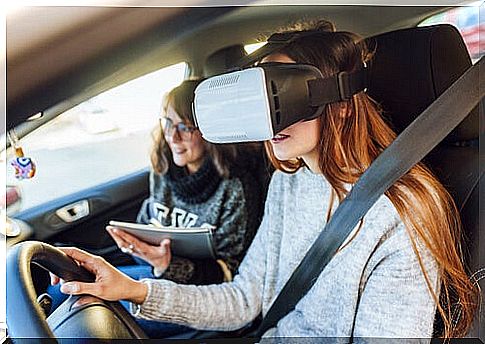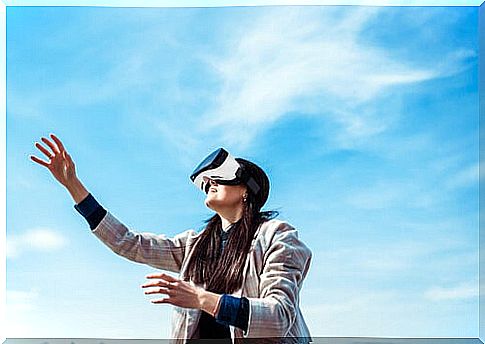Virtual Reality, A New Tool To Face Fear

A broad definition of virtual reality includes a large number of areas and applications. This name is usually reserved for computer technology that generates three-dimensional environments with which the subject interacts in real time. In this way, a sensation of immersion similar to that of presence in the real world is produced.
One of the hallmarks of virtual reality is the possibility of interaction. The subject is no longer in a passive position, he can move around the environment and interact with it in different ways.
In the future the computer will vanish. It will still be there, but its components will be much smaller and will be distributed among clothes, furniture and objects. The interface between the person and the computer will become so intimate that it will be difficult to know where the capabilities of one end and those of the other begin. Virtual reality already participates in this philosophy.
Virtual reality features
Presence and interaction are two fundamental properties of virtual reality systems. Presence is the feeling of “being in” the virtual environment. Subjects who pass through virtual reality environments do not have the sensation of observing from the outside. They are part of them.
There are different factors that contribute to increasing the feeling of presence in a virtual environment. Virtual reality headsets are the best known component. With them, the visual field of the subject is practically covered by the information that comes from the virtual environment.

If the subject has possibilities of interaction with the virtual environment (moving around, touching objects, moving them, etc.), their sense of presence will be greater than if they must limit themselves to observing what happens. They are movement and feedback within this virtual world the cause of this gain.
First applications of virtual reality in psychology
The applications of virtual reality are present today in a large number of fields. From entertainment to simulations with which you train to operate different types of machines. There are also visualization systems that help to understand complex mathematical conceptual systems.
In psychology, the main applications that have been developed so far have to do with exposure techniques. They are commonly used to treat phobias. In addition, progress has also been made in other fields such as eating disorders. There are also already numerous applications of virtual reality for psychic and psychomotor rehabilitation.
It is difficult to locate in time the pioneering contributions on applications of virtual reality in mental health with precision. However, among the antecedents we could consider studies in which the efficacy of some type of rudimentary tool was tested. For example, special glasses that altered depth perception. They were used to magnify the feeling of height during the treatment of a phobia of heights.
Treatment of the phobia of flying through virtual reality
Probably the area of greatest development of the current applications of virtual reality on mental disorders is that of phobias. The phobia of flying is one of the most frequent phobias. It has very important negative consequences for the people who suffer it. The phobia of flying limits their movements and reduces their social and work possibilities.
The characteristics of the phobia of flying make this disorder especially well suited to some peculiarities of virtual reality. First, the subject is sitting in a confined space. It is easier to reproduce their behavior in a virtual environment and it is much cheaper than a live exhibition.

Wiederhold, B., Gevirtz, R. and Wiederhold, M. examined the effects on the body of a flight phobia treatment using virtual reality. Physiological activation measures (sweating, palpitations, tremors, etc.) decreased significantly in patients who received this treatment for four sessions.
In another study, the efficacy of a virtual reality intervention applied to 31 patients was examined. After treatment, 21 patients were able to fly. Similar studies were subsequently carried out to treat the fear of open spaces or leaving the house (agoraphobia). The results showed that attitudes towards agoraphobic situations decreased in the group that was treated through virtual environments.
Virtual reality applied to social phobia
North, MM, North, SM and Coble, JB have applied virtual environments in the treatment of some characteristic symptoms of social phobia (fear of social interactions, public speaking, etc.). The patients participated in a weekly 15-minute session for 5 weeks. Subjective measures of anxiety were significantly reduced. Attitudes towards situations involving public speaking also improved.
Likewise, it was observed that the subjects correctly transferred the learning carried out in the virtual environment to real situations. In these situations, with an audience already real, it was observed how a previous therapy with virtual reality decreased the anxiety of these people.
Treatment of fear of driving through virtual reality
In our society, one of the most important causes of post-traumatic stress is traffic accidents. Among its consequences is the appearance of an intense fear of driving. Virtual environments that simulate driving may be appropriate to reduce this fear.

The virtual environment allows you to reproduce different traffic conditions without the risk of real driving. In this way, the treatment of fear is made easier and carries less risk.
Spider phobia and virtual reality
Spider phobia also received early attention from researchers. Albert Carlin, Hunter Hoffman, and Suzanne Weghorst of the University of Washington reported a case in which a patient’s spider phobia was successfully treated using virtual reality and augmented reality techniques.
Currently, virtual reality is used in a wide spectrum of psychological problems. Phobias, post-traumatic stress, generalized anxiety, depression, or obsessive compulsive disorder are just one example . On the other hand, as you need a specific and adapted technology, you also need a psychologist trained in the use of these types of resources.
Little by little the technical requirements are being perfected in favor of science and psychological treatments. Thus, a new horizon full of possibilities opens up for patients to overcome their limitations and problems. The future is already a reality. Welcome to virtual reality.









